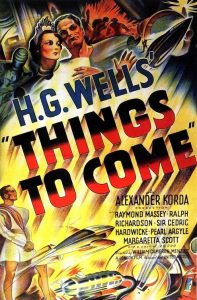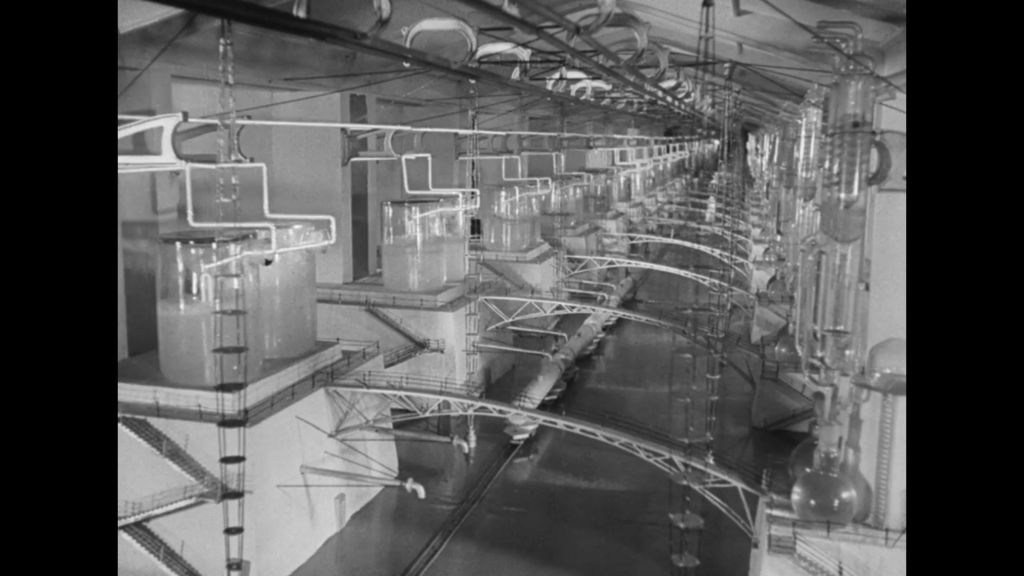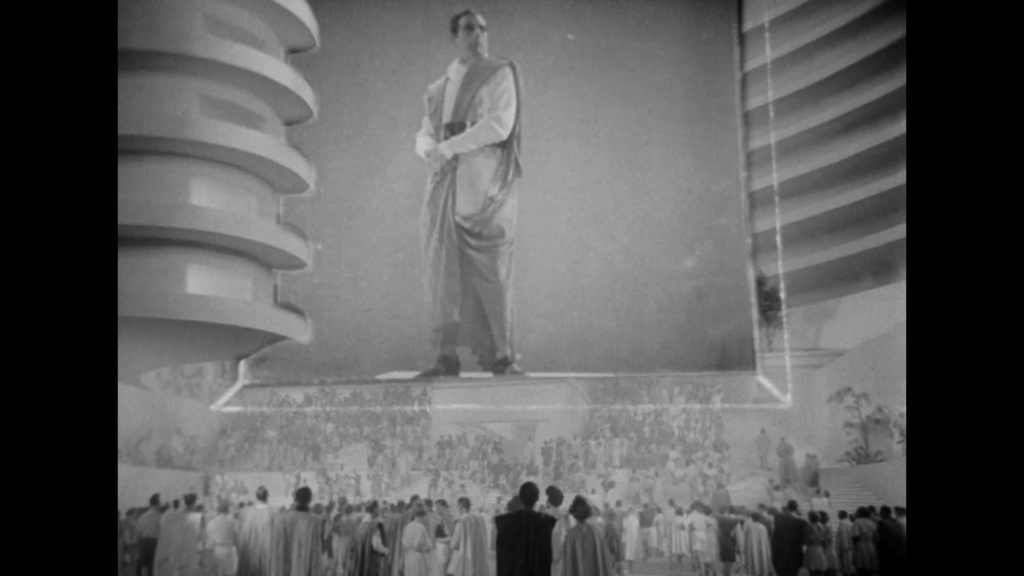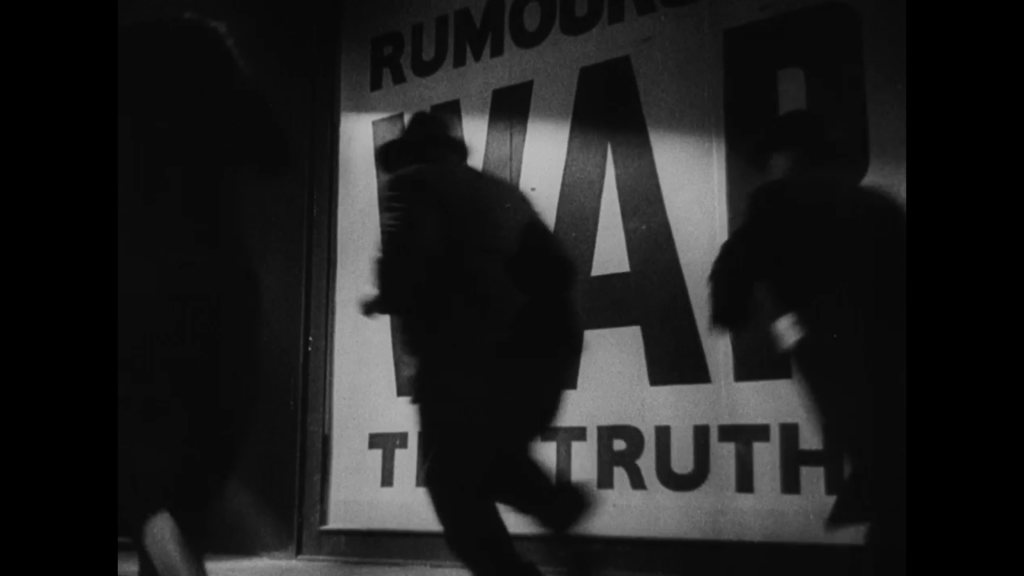|

Synopsis:
After the onset of plague-inducing global war, the tyrant (Ralph Richardson) of Everytown is visited by an aviator (Raymond Massey) who hopes to bring peace and progress through his organization Wings Over the World. After decades of technological advancement, all humans are living underground in a leisurely communal society — but a sculptor (Cedric Hardwicke) urges society to resist ceaseless advances, and a battle ensues over whether to send a “space gun” to the moon.
|
|
Genres:
- Ralph Richardson Films
- Raymond Massey Films
- Science Fiction
- World Domination
Response to Peary’s Review:
Peary writes that this “monumental, extremely ambitious, and lavish Alexander Korda production” — the “most expensive British film of the time” — possesses “truly innovative special effects and bizarre set designs and ‘futuristic’ costumes’ [that] are still of interest”, but “what gives [this] fantasy special interest is that it was scripted by 70-year-old H.G Wells”, whose goal was to write a “predictive history” rather than purely speculative fantasy. Peary notes that the “film depicts [the] Wellsian view that near future will be catastrophic but in time man will build a marvelous, peaceful world”, and points out that “this is the rare SF film that is pro-scientific advance, pro-knowledge, pro-technology”. He adds that “unfortunately, Wells’s spokesman… sounds today like a lunatic when he delivers his final speech about mankind spreading out into the universe”, and notes that the “picture is dated and flawed in other areas”; he ultimately posits that the film “presents a futuristic vision that is at once ridiculous and fascinating”.
Peary’s take on this film remains accurate: it’s impossible not to stare at the “architectural wonders” on display, and wonder if we might one day find some way to live in global peace and harmony through technological advances. However, the hive-like nature of the underground village looks uncomfortably like an antiseptic ant hill — and, as pointed out by DVD Savant, “we of course aren’t told how the population is controlled, or where all the non-Anglo people might be.” Savant further points out that “the imagery is also uncomfortably close to depictions of racial glory in Nazi art: unyielding Nordic faces seeking perfection in the stars.” The characters themselves are noticeably flat: with Wells caring most about the accuracy of his vision, and director William Cameron Menzies primarily concerned about the sets and visuals, nuanced performances and meaningful character arcs are missing. However, that doesn’t seem to matter as much as one would think: this really is a broad-scope tale of a planet in transformation, attempting to move beyond barbarian conflict and literally towards the stars.
Note: Interestingly, Peary writes in his review that “Wells’ script was greatly revised by Lajos Biros and [Wells] detested the finished film”, but this isn’t discussed in the extras provided on Criterion’s DVD release. Rather, according to Criterion’s website:
Wells, at the height of his popularity as a best-selling author and monumental cultural personality, held a huge amount of sway over all aspects of the production. There was one battle he did not win, however; although he wanted the film to be presented as “H. G. Wells’ Things to Come” and have no on-screen credits, relying instead on programs handed out to audiences to supply the credit information—“This is a long-needed innovation upon cinema practice,” he said. “Few people remember the names that are just flashed on the screen” — ultimately, the credits appeared in both places.
Redeeming Qualities and Moments:
- Magnificent sets and art production



- Highly effective cinematography


Must See?
Yes, as an early (albeit flawed) classic of the genre, and for the fantastic art design.
Categories
(Listed in 1001 Movies You Must See Before You Die)
Links:
|






2 thoughts on “Things to Come (1936)”
I watched this some time last year for the first time, so my recall is a little vague, and unfortunately not the pristine Criterion remaster (that would have been nicer for sure). I do remember the design being captivating, but the overall production as more of an eccentric, stilted curio than that of some timeless and innovative masterpiece. I agree with your assessment of a must-see, it’s worth the viewing but probably wouldn’t hold up to repeated viewings.
First viewing – a once-must, for its place in cinema history, and as a fine example of speculative fiction.
Personally speaking …considering the time it was made, I find this a fascinating work, esp. as it contemplates alternatives to man’s tendency toward war. Since this is essentially a film of ideas and, therefore, fleshed-out characterizations are secondary and necessary only insofar as they support the ideas …the ‘flatness’ of the characters does not seem that troublesome (or even, really, much of an issue).
Yes, of course now some of the effects now look silly, but the amount of imagination expressed at the time through this film remains impressive.